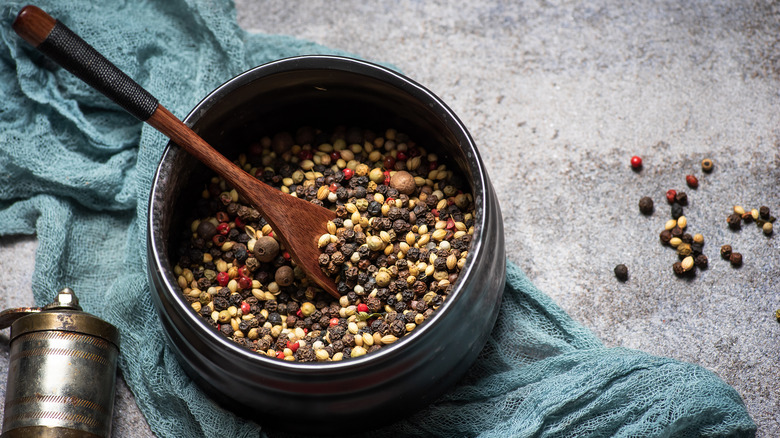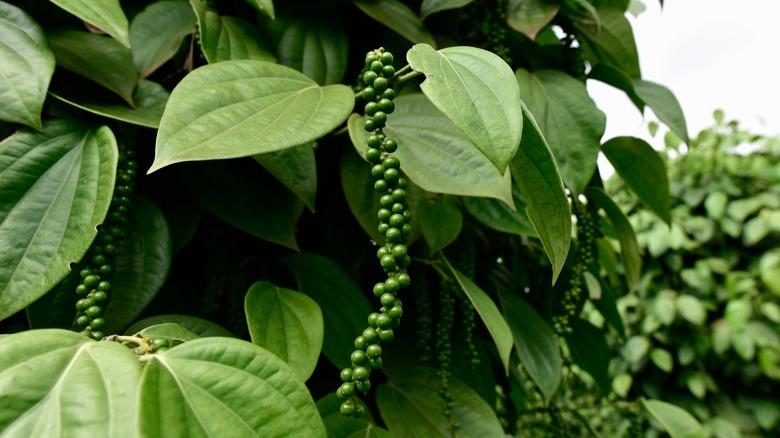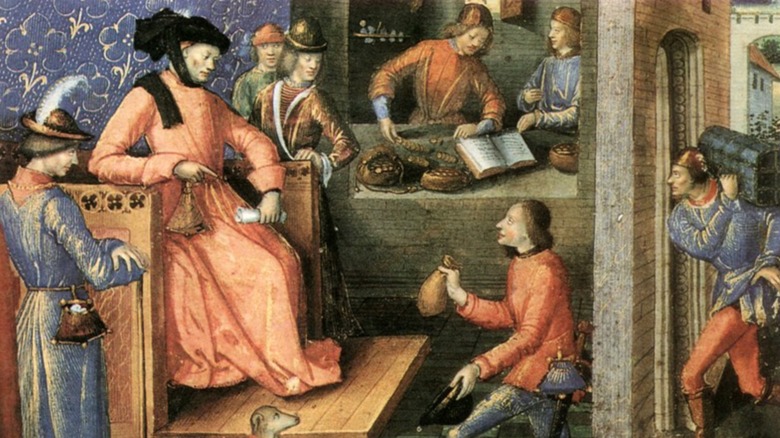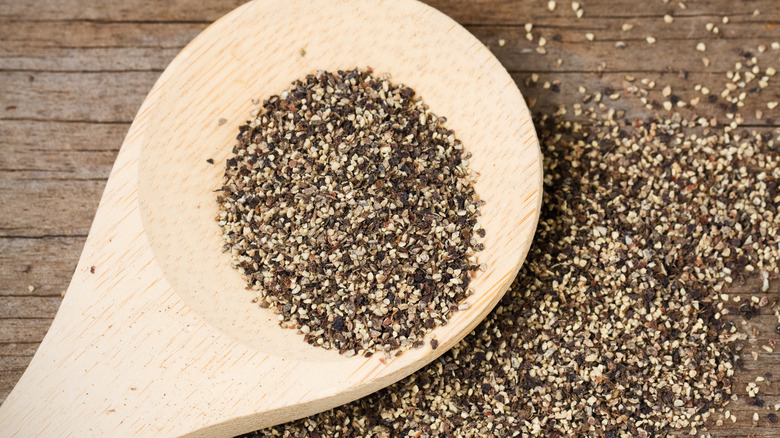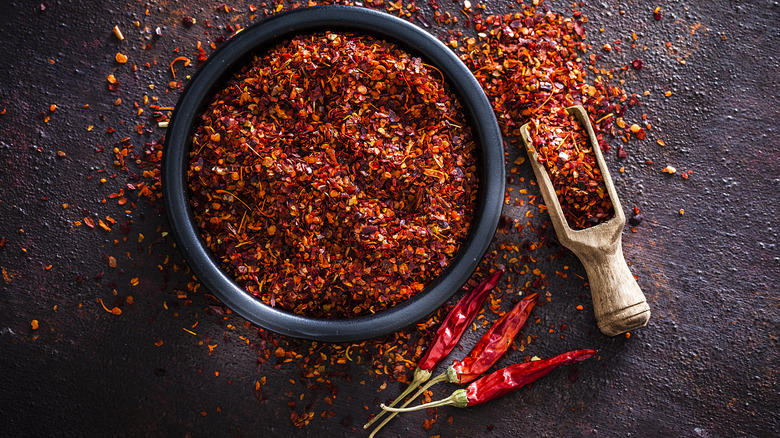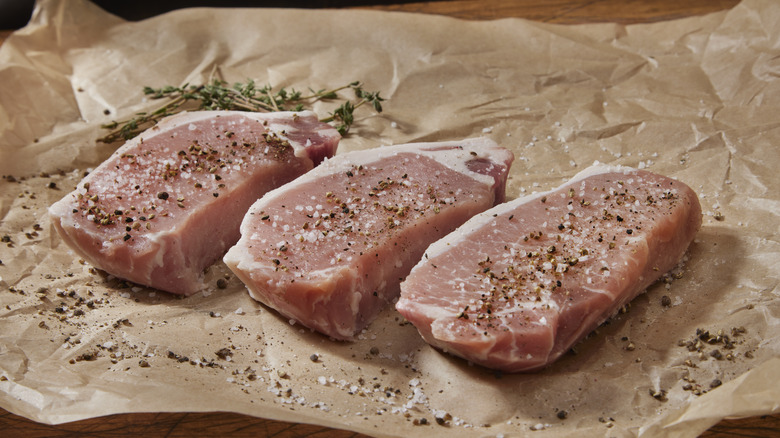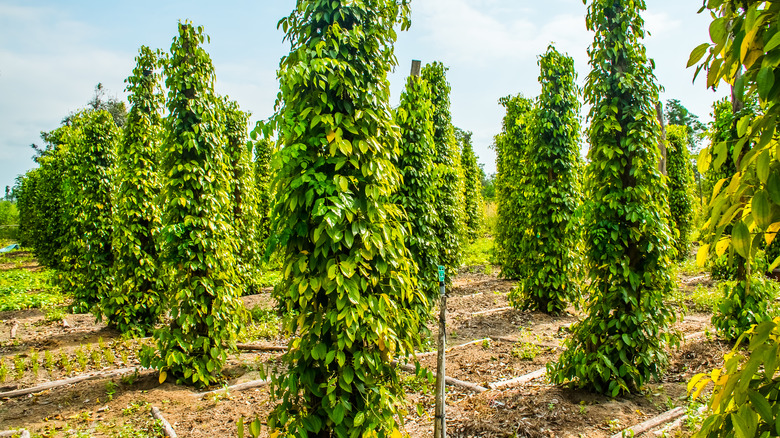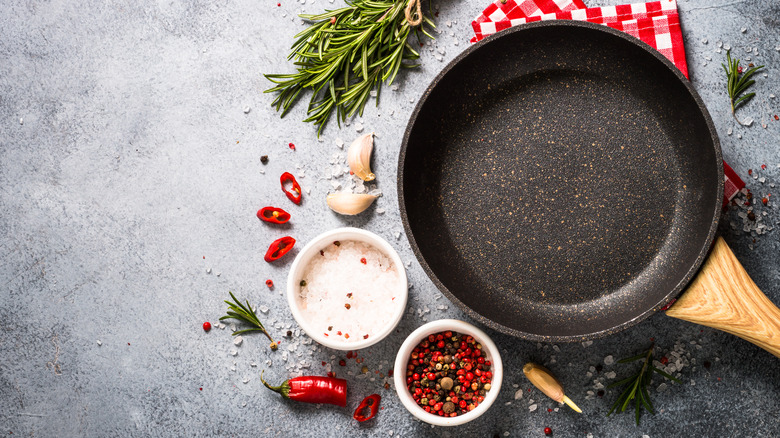12 Little-Known Facts About Pepper
Pepper is an inescapable ingredient that still somehow manages to fly under the radar. It's not as addictive or pivotal as salt nor as exciting as red chili flakes. You might notice if it wasn't in its perennial place next to the salt shaker, but you probably wouldn't mourn its absence in your food. Where salt is non-negotiable, pepper can seem like more of a table ornament than an essential ingredient. But there's a reason this seasoning is given equal pride of place on dining tables as salt. Pepper has been a prized commodity for centuries, deeply intertwined with trade, class, and politics. From its origins in South India to its rapid spread around the globe and onto nearly every dining table in modern America, it has reached a level of ubiquity that few spices can claim.
Despite its ubiquity, however, there are many things about this seasoning that are not known to the millions of people around the world who sprinkle on their meals every day. Even beyond its extensive history, its various colors and varieties, and its surprising uses in medicine, gardening, and car repairs, pepper is hiding a lot up its sleeve. It's a secret superstar in perfumery, for example, takes an unusual form in outer space, and, depending on where you've purchased it, may not even be pepper at all. So, without further ado, let's get into some of the more obscure facts about pepper that even pepper enthusiasts might not know.
1. Peppercorns are actually fruit
When many of us think of fruit, we conjure images of oranges, apples, bananas, and berries, but probably not pepper. Spices are often put in their own category of food, but in reality, they are made from many different parts of their respective plants. Cumin is a seed, for example, while coriander is a seed pod. Cloves are flower buds, while ginger and turmeric are roots. Then there's cinnamon, which is the bark of a tree.
Peppercorns, which are often purchased in a powdered or roughly ground form, are the fruit of a flowering vine called Piper nigrum. Native to southern India, these vines prefer a warm, humid climate where they can climb more than 30 feet, winding their way around tree trunks. To make the pepper that we recognize and purchase for our pepper shakers, peppercorns are harvested when they are still green and unripe, then are left to dry and blacken. If they are left on the vine, they turn white as they ripen, creating a different product known appropriately enough as white peppercorns.
2. Pepper was once so valuable that it was used as currency
The last time we checked, you can't pay your landlord in peppercorns, but once upon a time, it might have been the preferred form of payment. Back then, it would be more likely that you'd have a few pounds of gold lying around than a few pounds of pepper. The seasoning was once so rare and treasured that it fueled entire economies, ignited colonialism, and even enabled Christopher Columbus' journey across the Atlantic. When the king and queen of Spain funded his trip to the New World, he was told to bring back gold and peppercorns.
Centuries earlier, in the year A.D. 410, the value of pepper was just as high. When the Visigoths arrived in Rome and brought the city to its knees, they demanded a high ransom in exchange for releasing the city from their grasp. Their requirement? Gold, silver, and 3,000 pounds of peppercorns. In addition to rescuing cities from sieges, peppercorns were accepted forms of currency for dowries, rent, and even taxes.
3. Ground pepper isn't always made of pure peppercorns
There are all sorts of filler ingredients padding out our foods, whether it's maltodextrin beefing up the dimensions of potato chips or cellulose adding some cheap volume to ice cream. But pepper? Surely, it's immune to food additives, right? Sadly not. Unless it's marketed as 100 percent peppercorns, you may not be purchasing pure pepper. To be more precise, you might be purchasing a seasoning made of some proportion of ground-up twigs, leaves, and even sand. Common additives that are slightly more appetizing include papaya seeds, sorghum, and coffee husks, but it's safe to say that when you buy pepper, you'd prefer that it actually be pepper.
One of the reasons counterfeit pepper is so difficult to control is that the supply chain can be murky. From pepper vines to grocery store shelves, peppercorns pass through many stages, many of which may be overseen by different entities. Padding out pure peppercorns with filler ingredients is cost-effective, and if no one knows the difference, it's an easy gamble to take. Some restaurants opt for synthetic pepper instead. Until 2015, restaurant chains including Taco Bell were using the opaquely named "artificial black pepper" (the precise ingredients of which were proprietary information, according to the Los Angeles Times) before switching to something with the equally vague name, "natural black pepper flavor." To avoid eating ground-up twigs or artificial flavoring, the best approach is to simply buy whole peppercorns.
4. The word is a homonym
If you've ever wondered what bell peppers and the black powder inside your pepper shaker have in common, you've alighted on a feat of culinary deception that has plagued our lexicon for over 500 years. Black pepper (Piper nigrum) is a species of the genus Piper, which is part of the Piperaceae family. There are over 3,600 species in this family and not a single one of them is a chili pepper. This type of pepper, whether it's a bell pepper or a Trinidad Moruga scorpion, falls into the genus Capsicum, which belongs to the Solanaceae family. Black pepper and chili peppers have almost nothing in common except the kick of heat that many of them provide and the fact that they're both fruit. The person responsible for the confusion is the same person responsible for conflating Native Americans with Indians, even though they lived on different sides of the world. That's right — Christopher Columbus.
What he lacked in botanical expertise, the explorer made up for in creativity. Columbus was supposed to sail to Asia to procure gold and pepper, but instead, he landed in the Caribbean, where he noticed that the fleshy fruits that the Taíno people used to spice their food provided a similar function to peppercorns. Seizing the opportunity, Columbus wrote to the Spanish crown, referring to the fruits as peppers that were even better than peppercorns. He succeeded, and we're left with a single word for two completely different foods.
5. It can be used as a preservative
Pepper can make almost any dish taste better, but its talents don't stop there. It can also prolong the shelf life of your food, a feature that made it particularly popular before modern refrigeration became widely available. In fact, it's difficult to know whether pepper became so highly coveted in ancient times because of its flavor and medicinal qualities, or because of its ability to preserve food. At a time when storing raw meat wasn't as simple as rearranging a refrigerator shelf, anything that could extend its shelf-life was a prized commodity.
The efficacy of using pepper as a preservative isn't just a hunch based on wishful thinking. Modern science has helped to prove it. A 2015 study published in the Journal of Food Science and Technology found that pepper extract was an effective defense against E. coli and Staphylococcus aureus because it damages their cell membranes. This doesn't mean that you should start keeping your meat on the counter smothered in black pepper, but it does indicate that medieval cooks were onto something.
6. It can be the lynchpin of sweet recipes
Salt and pepper often sit next to each other on the dining table, which suggests that they act as a culinary pair. However, pepper is even more versatile than salt, and where you might not want to add salt to certain recipes, you might love the results if you add pepper to them. Chief among this category is desserts. A sprinkling of freshly ground peppercorns can turn a sickly sweet concoction into a bold, well-balanced treat that will have people asking for the secret ingredient.
It isn't all that surprising when you think about it. Ginger has a fiery kick that makes ginger snaps and gingerbread what they are. Even apple pies have heat to them sometimes, depending on how much cinnamon is involved. Pepper provides the same effect without the distinctive flavors of other spices. It's a neutral heat that won't distract from the main ingredients in the recipe, making it an ideal addition to sweets that have mild flavors. For example, if you're making a pear crisp and want it to taste more floral and fruity than spiced, swap ginger and cinnamon for a few grinds of pepper. In Iceland, there is an entire cookie based around the pepper. Piparkokur is a recipe built around two modest ingredients — pepper and a sugar cookie — which turns into far more than the sum of its parts.
7. Vietnam has become the largest producer of pepper
Although India is normally the first country that springs to mind in relation to pepper, Vietnam is actually the largest producer of the ubiquitous seasoning, by far. Precise numbers vary regarding which country takes the second and third spots, but regardless of whether it is Indonesia, Brazil, or India, there is no question that Vietnam produces more than twice as much pepper as its closest competitor. In fact, its 220,000 tons of peppercorns account for 55 percent of the entire global pepper market (per Vietcetera).
One of the reasons that the country has become such a powerhouse in the industry is weather. The pepper vine needs a warm, humid climate to thrive, which limits where it can be produced. But aside from its favorable weather, Vietnam has another factor in its favor: trade. It is one of the few Asian nations to have established a free trade agreement with the European Union, giving it a distinct advantage over other pepper producers such as Indonesia. Statista estimates that Vietnam exported 10,000 tons to Germany alone in 2022.
8. Black pepper is a crucial ingredient in many perfumes
Pepper might have even more potential outside the culinary world than inside, whether most of us know it or not. Perfumery is one such sector. It may not be the ingredient touted on every label, but it plays a key role in the art and science behind perfume-making. Many fragrances feature powerful, exotic scents that are distinctly floral, sweet, woody, or warm. Pepper acts as a moderator, cutting through the intensity, lifting warm fragrances, or giving sweet perfumes a much-needed edge.
In the world of perfumery, it is known as a top or a middle note, either offering a first hit of fragrance to moderate the most prominent scents or providing a spicy, warm heart to the final aroma that emerges in a complex perfume. Pepper can also act as a preservative in fragrances in the same way that it used to be used as a food preservative, though this is more of a bonus than a primary function.
9. Black pepper may help with weight loss
There is no end to the number of claims about certain ingredients being a miracle for weight loss, and many of them are spurious. However, when it comes to pepper, several studies have found that it may be one of the exceptions. One study published in the Indian Journal of Pharmacology found that when rats with a high body weight were given large doses of piperine, a compound in pepper, they lost weight and had lower cholesterol without having to adjust their high-fat diet. The results suggest that piperine can jump-start metabolism when administered in the right quantity. A similar study published in Nutrition Research found that rats who were given different doses of piperine saw a reduction of fat in their livers and improved insulin resistance, which has particular implications for those with type 2 diabetes.
Studies performed on rats should always be taken with a grain of salt (pun intended) when applying the findings to humans, but these studies and others provide ample reason to continue exploring piperine as a potential aid to weight loss. That said, you are not likely to see results if you simply add a few extra grinds of pepper to your meal.
10. Astronauts use liquid pepper in space
If you've ever been to a space museum, you might have sampled some of the foods that historically populated spaceship pantries. They are predominantly powdered or freeze-dried versions of familiar favorites like ice cream and are not particularly appetizing once the novelty wears off. As technology improves, however, the options are more diverse, with astronauts being able to enjoy steak, fruit salad, and soup almost as if they were still on planet Earth.
There is no getting around the physics of space, though, and things have the tendency to float away. For this reason, food packages are affixed to trays with Velcro, and bread is banned outright to avoid the spread of levitating crumbs. Even astronauts rely on salt and pepper as a foundational seasoning combination in space, but in zero gravity, classic shakers pose a serious risk. Imagine getting floating pepper in your eyes instead of on your mashed potatoes, or looking up to discover that salt granules are coating your control panels or clogging the ventilation system. The solution is to turn these seasonings into liquid. Salt is dissolved into water and pepper is added to oil. Liquid is not immune to zero gravity, but it does tend to be more manageable because of surface tension.
11. Cambodian Kampot pepper has protected origin status
There are many types of peppercorns out there, from the white variety that is harvested when peppercorns ripen to pink peppercorns that come from a different type of pepper plant altogether. If you go to specialty stores, you can find myriad examples of rare and pricey peppercorns, from woody Voatsiperifery from Madagascar to smoky, oblong Timiz peppercorns from Ethiopia. One of the most prized varieties in the world is Kampot pepper, which originates from Cambodia. Known as the "champagne of pepper," it has a floral, citrusy aftertaste and pungent flavor that make it a more complex seasoning than regular black peppercorns.
Kampot has endured a rocky history. Hailed as a superior seasoning as far back as the 13th century, its production took off during the 19th century when French colonists developed an appetite for it and began ferrying it back to exclusive restaurants. Cambodia was producing 8,000 tons per year in the early 20th century, but the industry was swiftly cut off during the brutal Khmer Rouge regime in the 1970s, pushing the industry to the brink of demise. Over time, however, Kampot farms have experienced a renaissance, leading to a historical achievement in 2016 when the European Union granted it a Protected Geographical Indication. The distinction, which is shared by other origin-specific products like Chianti and Gouda, ensures, among other things, that products labeled as Kampot are produced in the Kampot region and are grown without chemical fertilizer.
12. We should all be toasting our peppercorns
Perhaps you've noticed that recipes for curries and other aromatic sauces often call for sautéing the seasonings before adding the other ingredients. This isn't just a ploy to make your kitchen smell nice or give your spices a toasted flavor. It's a way to release their essential oils so that they are more fragrant and flavorful. Like cumin and mustard seeds, peppercorns are full of essential oils that are packed with compounds that provide distinctive flavors and aromas. In the case of black pepper, there is Limonene, a citrusy compound; Pinene, which provides a pine-like scent; Eugenol, which provides the woody aroma to cloves; and Phellandrene, which is a compound in eucalyptus and peppermint. While you might not be able to identify each aroma after grinding a quarter teaspoon over your pasta, you will experience more flavors than you would if you hadn't toasted it.
You don't have to splurge on fancy peppercorns to achieve this effect. Even the drabbest peppercorns can be revived, so don't be embarrassed by the questionable quality of that tub you bought in bulk from Costco 10 months ago. All you have to do is roast them in a dry skillet until they begin to pop and release fragrance. Let them cool completely before storing them to avoid mold-breeding moisture. You can either grind them up before you store them or, for peak flavor and freshness, wait to grind them until you're seasoning food.
